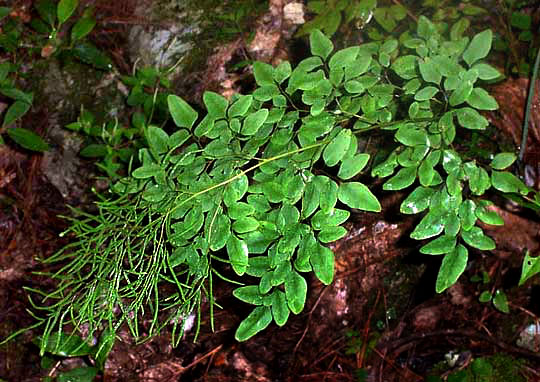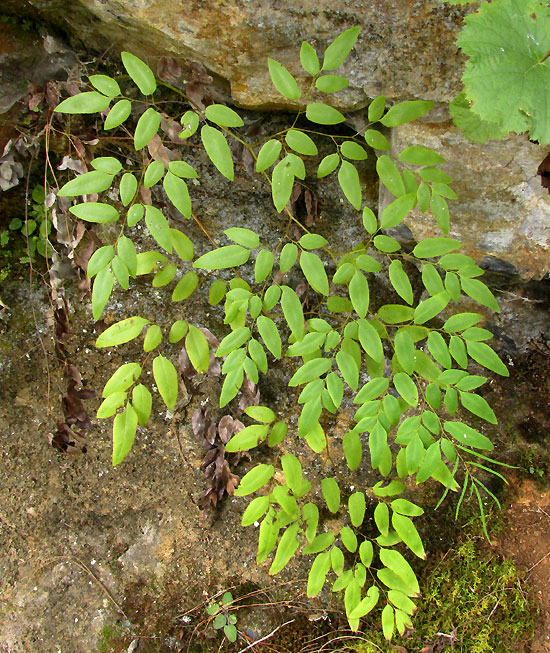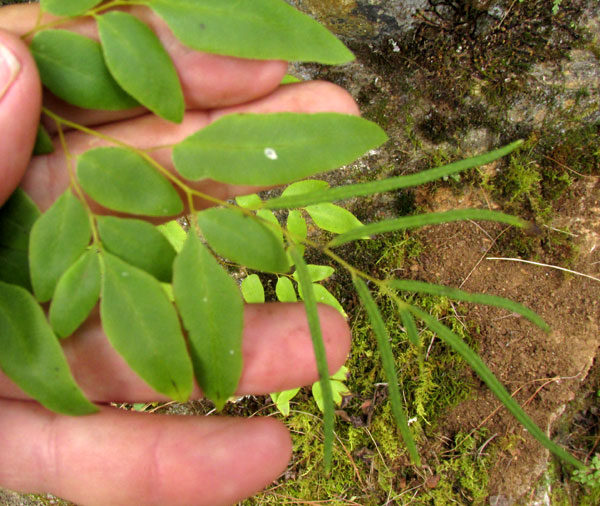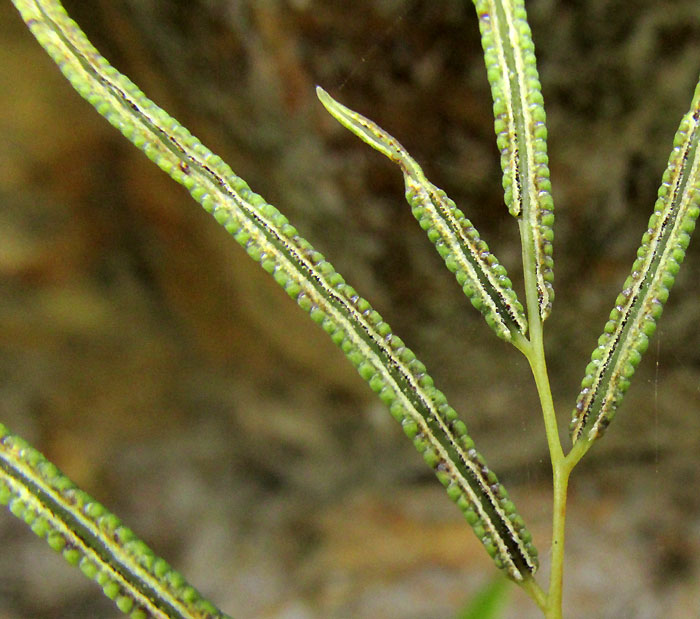Excerpts from Jim Conrad's
Naturalist Newsletter
from the August 3, 2007 Newsletter,notes taken in the Sierra Gorda Biosphere Reserve, just south of El Madroño in the Eastern Sierra Madre Mountains, elevation about 1800m (5900ft), ~N 21.28° E 99.12°, QUERÉTARO, MÉXICO
A MONOTYPIC FERN WITH NO ENGLISH NAME
In that humid, shadowy, pretty little valley with many big-leafed magnolias, in the moistest, most shadowy corners where white limestone rocks jutted from moss-encrusted soil, a seldom-seen fern was common. You can see it, still wet at midday from the night's rain, below:

The fern is LlAVEA CORDIFOLIA, and I can't find a common name for it. It's found in Mexico, Guatemala and Costa Rica.
Average ferns have their spore-producing "fruit dots," or sori, on the undersides of their fronds' leaflets, or pinnae. This fern has segregated its sori onto very slender, cordlike pinnae at its fronds' tips. On older fronds the fertile parts were dark brown, giving the appearance of being diseased.
Some other ferns also produce different-looking, spore-producing pinnae on their fronds -- such as the Interrupted Fern, Osmunda claytoniana -- but I can't think of any who do it quite like this. In fact, this unusual placement of the fertile pinnae helps explain why there is only this single species in the entire genus Llavea -- and sometimes the genus Llavea has resided alone in its own family, the Llaveaceae.
When a genus is represented by only one species, it's said to be "monotypic." Often with monotypic species it's a good guess that once several species existed, but all but that one went extinct. That's the way it is with Ginkgos, for instance. Once many ginkgo species existed but now there's only one, Ginkgo biloba.
So, already I was feeling as if I had stepped back in time when I entered that secluded little valley. When I found Llavea so well established in its refuge, the feeling only grew.
entry from field notes dated January 19, 2023, taken along steep, one-lane gravel road ascending forested, northeast-facing mountain slope, elevation ±2,380m (7600 ft); bedrock of Cretaceous limestone; on the south side of Pinal de Amoles, Querétaro state, MÉXICO, (N21.134°, W99.629°)
MORE ON THE LLAVEA FERN
Years after the above entry was made I'm back in Querétaro state, but this time with much more information about the Llavea fern, and a better camera. Again our fern is on high elevation limestone:

 At the right, you see that on this individual, compared to what we saw earlier, there are many fewer fertile segments relative to the broad infertile ones. The view below shows the undersides of some fertile segments, with blackish sporangia sheltering beneath the segments' curved-under margins.
At the right, you see that on this individual, compared to what we saw earlier, there are many fewer fertile segments relative to the broad infertile ones. The view below shows the undersides of some fertile segments, with blackish sporangia sheltering beneath the segments' curved-under margins.

Since writing the earlier entry in 2007, genetic research has made clear that Llevae cordifolia doesn't warrant having its own family consisting of just this species, for it is nested within the large Maidenhair Fern Family, the Pteridaceae.
Also, within the Pteridaceae family, it's the most primitive species of the most primitive subfamily, the Cryptogrammoideae, as nicely shown in a "phylogenetic tree" in the 2007 paper by Eric Scheuttpelz and others entitled "A molecular phylogeny of the fern family Pteridaceae: Assessing overall relationships and the affinities of previously unsampled genera." In phylogenetic terms, it's "basal" in the Maidenhair Fern Family.
Also since the earlier entry, Llevae cordifolia has been recognized as growing in the US -- on a limestone bluff in Big Bend Ranch State Park along the Mexican border in southwestern Texas. It had been collected in 1992 but was identified as an aberrant royal fern, genus Osmunda, and only recognized as a Llevae in 2010. This is reported in the 2011 article by Robert O'Kennon and George Diggs entitled "Llavea cordifolia (Pteridaceae), New for Texas and the United States."
In the 2016 publication by Mónica Palacio-Rios and others entitled "Revisión del género monotípico Llavea (Cryptogrammoideae: Pteridaceae)," I read that in the southernmost Mexican state of Chiapas Llavea cordifolia is used to cure mange. The leaves are mashed and administered as a plaster three times a day for two days. Also, when one has a shoulder pain brought about by a fast temperature change, handfuls of the entire plant are boiled in a pot and the resulting liquid is used to bathe the shoulder until the problem subsides. For treating edema, a similar boiling and application is performed, but this time adding pine (no mention of which part), and used as a bath twice a day for many days.